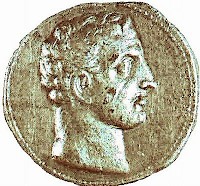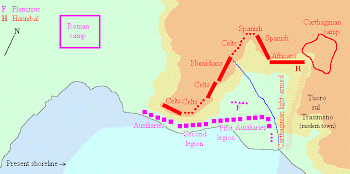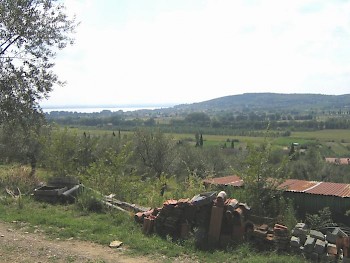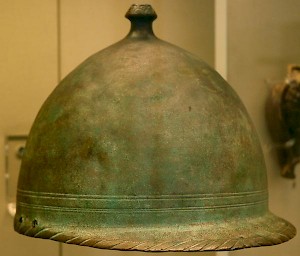Lake Trasimene (217 BCE)
Q207250Battle of the Trasimene Lake (217 BCE): important Roman defeat during the war against Hannibal, the Second Punic War.
The Trasimene Lake or, as it is called today, Lago Trasimeno, is one of the large volcanic lakes in Central Italy. It is filled by rain water and sweet water from little mountain streams; the site is well-known for its abundance of fish. Today, its surface measures 128 km² and it has a maximum depth of about six meters. In Antiquity, it was larger, but the Trasimene Lake has been partly emptied by several man-made canals that connect it to the river Tiber. The lake is still famous because of a battle in the Second Punic War, in which the Carthaginian leader Hannibal Barca defeated the Romans.
Preliminaries

In the autumn of 218, Hannibal had led his army across the Alps (more...) and had defeated the Roman commanders, Publius Cornelius Scipio and Tiberius Sempronius Longus, at the rivers Ticinus and Trebia, tributaries of the Po. The presence of an enemy south of the Alps greatly alarmed the Romans, and the consuls of the year 217, Gnaeus Servilius Geminus and the popular Gaius Flaminius, knew they were supposed to do something. No less than eleven legions were active, and it was decided to give up the plains of the Po, where the Carthaginian cavalry could not be defeated. Instead, Hannibal was permitted to invade Etruria, where the hills were better suited for Roman heavy infantry.
Consul Flaminius was sent to Arretium (modern Arrezo) with two legions of 5,000 soldiers each, 10,000 Italian auxiliaries, 1,000 archers, 1,000 light-armed men, and between 2,500 and 3,500 cavalry. He had to guard the western passes of the Apennines. Meanwhile, his colleague Servilius guarded Ariminum (Rimini). A third army was to defend Rome. Wherever Hannibal chose to cross the Apennines, he would meet a strong Roman army, and would always be trapped between at least two armies.
Hannibal chose the western road to Etruria (which is identical to the modern highroad between Bologna and Florence), crossed the marshes along the swollen river Arno, and -making a detour through the country west of Arretium- reached Cortona, south of Flaminius' base. This was a dangerous maneuver because it exposed his flank to Roman attacks, but Hannibal needed to force a battle with this consular army before it had united with the other Roman force. Flaminius, however, was too clever to swallow the bait.

So, Hannibal passed along the Roman army at Arretium and could proceed to Rome or to the east; in both cases, he would be trapped between the forces of Flaminius and another army. He choose to move to Perusia (Perugia) in the east, and Flaminius carefully tailed him, taking care not to come too close, because the Carthaginian cavalry could attack reconnoitering soldiers. As a result, the Romans did not know exactly what Hannibal was doing.
Battle

In the early morning of 24 June 217, consul Flaminius ordered his army to proceed from its camp (near the modern railroad station of Terontola) to the Trasimene Lake, which was reached east of modern Borghetto. From here, the legionaries followed an enemy they believed to be half a day to the east. However, Hannibal had ordered his army to occupy the hills along the lake.
The slopes were covered with forests and an early morning fog, which creeps up from the lake before sunrise, covered the landscape. Too late, the Romans realized that they had marched into a trap. This picture above shows what the battlefield from the northeast: this is more or less what Hannibal would have seen had there been no fog. The Roman army marched into the trap along the road between the lake and the hill you can see in the background.

The Romans could not move to the south, because the lake is too big to swim across; they could not continue to the east, where light-armed men blocked the road near the modern town Tuoro sul Trasimeno; return was impossible, because the Celts in Hannibal's army blocked the retreat; the only thing the Romans could do was prepare for battle and fight to an enemy charging from the north. However, the auxiliaries at the end of the column were completely destroyed at the beginning of the battle, and the Romans were from the very start of the battle under great pressure from their left and right. After about two or three hours, the two legions were annihilated and Flaminius had met a hero's death.

At least 15,000 men were killed. One group that had managed to break through the Carthaginian lines and had marched to the east, was later rounded up by Hannibal's superior cavalry. The Roman allies who were taken captive received favorable terms, because Hannibal hoped to destroy the system of Roman alliances. However, during the next days, the Carthaginian general discovered that he had not reached this strategic aim yet: even after he had defeated the advance guard of the army of the other Roman consul near modern Assisi, this town refused to surrender.
Aftermath
In Rome, Quintus Fabius Maximus was appointed as dictator, and he tried to wear out the Carthaginians. This was a successful tactic, but the consuls of 216 decided to attack the invader head-on. Although the result was the disaster at Cannae, after which a part of the Roman alliance did indeed begin to collapse, the allies remained loyal, just like Assisi had been after the Roman defeat at Lake Trasimene.